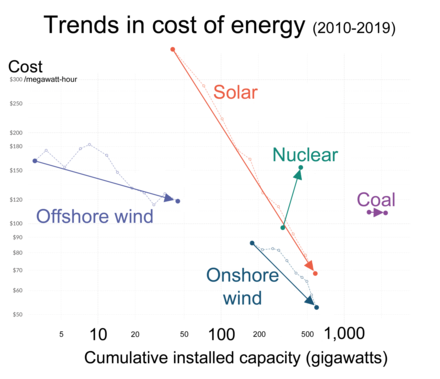Talk:Renewable energy commercialization
Appearance
| This is the talk page for discussing improvements to the Renewable energy commercialization article. This is not a forum for general discussion of the article's subject. |
Article policies
|
| Find sources: Google (books · news · scholar · free images · WP refs) · FENS · JSTOR · TWL |
| Archives: 1Auto-archiving period: 2 months |
 | Renewable energy commercialization was one of the Geography and places good articles, but it has been removed from the list. There are suggestions below for improving the article to meet the good article criteria. Once these issues have been addressed, the article can be renominated. Editors may also seek a reassessment of the decision if they believe there was a mistake. | |||||||||||||||
| ||||||||||||||||
| Current status: Delisted good article | ||||||||||||||||
| This article is rated C-class on Wikipedia's content assessment scale. It is of interest to the following WikiProjects: | |||||||||||||||||||||||||||||||||||||||||||||||||||||||||
| |||||||||||||||||||||||||||||||||||||||||||||||||||||||||
The following Wikipedia contributor has declared a personal or professional connection to the subject of this article. Relevant policies and guidelines may include conflict of interest, autobiography, and neutral point of view.
|
Wiki Education Foundation-supported course assignment
[edit]![]() This article was the subject of a Wiki Education Foundation-supported course assignment, between 24 August 2020 and 12 December 2020. Further details are available on the course page. Student editor(s): LisaNali21, Yessbecerra.
This article was the subject of a Wiki Education Foundation-supported course assignment, between 24 August 2020 and 12 December 2020. Further details are available on the course page. Student editor(s): LisaNali21, Yessbecerra.
Above undated message substituted from Template:Dashboard.wikiedu.org assignment by PrimeBOT (talk) 08:01, 17 January 2022 (UTC)
Does not say anything about hydrogen
[edit]Everyone is now familiar with the idea of electric vehicles and electric heating, but hydrogen fuel is apparently the new thing being developed. See https://www.bbc.co.uk/news/business-55763356 92.24.177.142 (talk) 16:55, 12 February 2021 (UTC)
Issue of mass exploitation of slave labor in china
[edit]
LCOE is a measure of the average net present cost of electricity generation for a generating plant over its lifetime. As a metric, it remains controversial as the lifespan of units are not independent but manufacturer projections, not a demonstrated longevity.
References
- ^ https://www.americanmanufacturing.org/blog/report-finds-forced-labor-throughout-china-solar-panel-supply-chain/ Report Finds Forced Labor Throughout China Solar Panel Supply Chain Matthew McMullan. MAY 19 2021 "researchers in the United Kingdom 'released a report examining Chinese government-run labor programs that service the industries in the solar panel supply chain that runs through the Xinjiang Uyghur Autonomous Region"
- ^ https://www.nytimes.com/2021/06/24/business/economy/china-forced-labor-solar.html
- ^ https://www.eenews.net/articles/solar-industry-were-in-most-serious-crisis-in-history/ "Faced with the prospect of tariffs on Chinese-made solar panels in 2017, SEIA warned that the market would react badly to new duties, predicting that the price of new panels would reverse years of declines and jump back up to 2012 levels."
- ^ https://www.solarpowerworldonline.com/2021/08/u-s-solar-china-polysilicon-battle/ The U.S. solar industry has a Chinese problem Solar Power World August 9, 2021. "Desari Strader, then-head of government affairs for SolarWorld Americas.[Operator of the largest polysilicon production facility in the western world] “They were beating us on the cost of production,” Strader said of Chinese suppliers at the time. “We had just finished ramping up [to mono-PERC]. Of course the Chinese could come and dump [cheap panels] in the U.S. It was super easy. Then everyone is screaming that you can’t compete with [Chinese module prices.] Yeah, you’re right. We can’t compete with slave labor.”
- ^ https://www.scmp.com/news/china/article/3115771/us-moves-renewable-energy-wind-turbines-xinjiang-may-get-caught As US moves to renewable energy, wind turbines from Xinjiang may get caught in political tempest South China Morning Post "As more information emerges about the suspected use of forced labour in the region, the US government has begun restricting trade from the area."
- ^ https://www.irena.org/publications/2020/Jun/Renewable-Power-Costs-in-2019 IRENA.Renewable Power Costs in 2019
- ^ https://www.irena.org/newsroom/pressreleases/2021/Jun/IRENA-and-China-Sign-Landmark-Cooperation-to-Address-Climate-Change "IRENA and China agreed to strengthen co-operation on the promotion of climate finance and investment as well as the promotion of innovation, policies and technology in the area of renewable energy and climate change and facilitate enhanced international collaboration."
- ^ https://m.dw.com/en/germanys-solarworld-files-for-bankruptcy-again/a-43166235 Germany's Solarworld files for bankruptcy again 28.03.2018 "Competition from China, the world's largest producer of solar panels, has been a major headache for Solarworld. The Bonn-based company noted that EU plans to let protective tariffs against Chinese imports lapse made its position untenable"
- ^ https://www.reuters.com/article/us-solarworld-bankruptcy-idUSKBN1862MN German Sun King's SolarWorld to file for insolvency ..."overwhelmed by Chinese rivals who had long been a thorn in the side..." "Germany used to be the world’s biggest market for solar panels, with demand driven by generous government support that provided business for panel makers around the world, including Asia and the United States." Reuters May 10 2017
- ^ ref>https://www.solarpowerworldonline.com/2021/08/u-s-solar-china-polysilicon-battle/ The U.S. solar industry has a Chinese problem Solar Power World August 9, 2021. "Desari Strader, then-head of government affairs for SolarWorld Americas."If 30% of the cost of a panel is your polysilicon, and you’re not paying wages, [of course] they were beating us on the cost of production,” Strader said"
- ^ https://ourworldindata.org/cheap-renewables-growth
— Preceding unsigned comment added by Boundarylayer (talk • contribs)
Categories:
- Delisted good articles
- C-Class energy articles
- Top-importance energy articles
- C-Class Environment articles
- High-importance Environment articles
- Sustainability task force articles
- C-Class WikiProject Business articles
- Mid-importance WikiProject Business articles
- WikiProject Business articles
- C-Class Science Policy articles
- High-importance Science Policy articles
- C-Class Climate change articles
- Mid-importance Climate change articles
- WikiProject Climate change articles
- Articles edited by connected contributors




